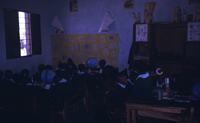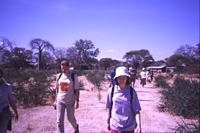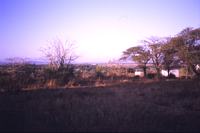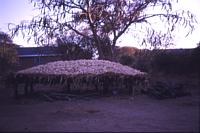Jo, being the victim of a Camera test. Part of the preparation was a huge 'spending spree' (How much is this trip going cost, I thought Tanzania was supposed to be cheap!) We had to get things like sheet sleeping bags, water purification tablets, and of course all those vaccinations. Yellow fever was probably the most frightening, the nurse said, after she'd finished the injection, "Don't leave if you're not feeling well, we're supposed to keep you here for ten minutes." I left, expecting to collapse in the street at any moment - but of course I didn't. The other medical issue was maleria, starting the Lariam tablets a week before departure really bought it home to me that I was going somewhere different - this is one of the strongest malaria protection you can have.
All Jo had to do was rush around, and worry about what would happen while I was away.
Liz,
a more willing 'victim', perhaps because she's going on the trip?
I drove us (Pete, Liz, Jean and Geoff to LHR, and Jo drove back.
I pulled into the departures area, but the other car, with the Dealls
(Jenny, Mandy), Paul and Julie went into the "Short Stay",
so they got to say goodbye in the airport.
On Tuesday July 2nd 2002, we flew from LHR to Abu Dhabi airport, where we had a long wait for another plane to Africa. There were a few shops, and Liz and I bought a sandwich to eat with our Lariam tablets.
We arrived in Dar es Salaam, and Martin was there with taxis already booked and waiting. So far none of the promised problems with Africa and things not happening on time had occurred. We were taken to the Econo-lodge where we spent our first night. This was not a bad hotel, with 3 to a room, but there was a bathroom with a shower, hot water, air conditioning and screened windows.
The next morning we had the continental breakfast in the hotel - fruit, toast & tea, bought lots of bottled water, and got taxis to the Scandinavia coach station. Scandinavia have "In God we Trust" as their logo across the back of the coaches. While we obviously agree with this, I'm not sure what impression its supposed to give (or is that my cynical western attitude?). Anyway we had seats booked, and it was quite comfortable, not like the Dalla Dalla's, but more of that later.
The road to Dodoma is at least all tarmac, well almost all. The journey time is about six hours. They have video on the coach, and serve fizzy drinks and biscuits. The drivers were Moslems, so the film was censored, by fast forwarding it, whenever there was a bedroom scene. There was one stop for a 'comfort break'. It was an opportunity to escape the seat, and stretch the legs...
... and whatever else. Sometimes its best to let people know when your taking their picture.
This
is Liz at the coach stop.
You can see now that we have moved
away from the coastal area, the ground is dry and dusty. The facilities
here are OK, if a little basic. We have our first taste of Tanzanian
traders, here they're quite friendly, and John buys some produce
and hands it round the coach party. We're here for about 15 minutes,
then its back on the coach for another long ride. At the other end
we are met at the coach station by two Land Rovers from Msalato
college, and cram all of us, the two that have come to meet us,
and the two Land Rover drivers into the vehicles for the ride up
the road from Dodoma to Msalato.
We
arrive at the college and are met by the students, they are very
friendly, speak excellent English, and are very please to see us.
We are grouped up and assigned houses and student 'friends', although
they will all become friends to some extent. Paul, John, and I and
sent to this house, and Johanna and Isaac are assigned to look after
us. The house consists of a central hall, a toilet/shower room,
2 bedrooms, and a room for washing cloths etc in. We have running
water in the shower room, to flush the french style toilet and to
take showers, and via a small tap on the wall. There are two separate
water supplies, neither of them are suitable for westerners to drink.
At this meeting we were also given a program for our stay. Many
visits have been planned, one to Mvumi, where friends of ours -
Alison and Peter - had hoped to be at about the same time. It would
have been lovely to see them there, but Alison was not well, so
their plans were delayed until Spetember.
This is Paul Hinckley, our team leader, and vicar wearing his customised 'Tanzania 2002' t-shirt. He's standing outside the new library, which we are going to help complete. This is a very nice building compared to some of the other buildings in the college. It may also house a computer room in the future.
These
are the girls in our party and their student 'friends':
- Back row: Jenny, Julie, Mandy
- Front row: Grace, Carrie,
Theresia, Liz
They are standing outside their house, this is much larger than the house the men are in, and houses more students.
We
visited the Bishop Stanway School.
It provides education for
the Standard I to Standard IV grades. This would normally equate
to the seven to eleven year olds. The children are very well behaved,
at least by comparison to the English school children that I have
seen.
We met the 'heady' master and did the formal introductions that were to become such a part of the ritual that must be performed on these occasions. Each of us was expected to introduce ourselves, starting with our name and say a few words about ourselves - what we do at home, or church. In the first few we started with the vicar, but later on would just go round the table from the host.
Bishop Stanway School is fee based. The fee for one year's education is 60,000/-. A peasant wage in Tanzania is about 70,000/-, and on top of the fees, equipment, and uniform must be provided. This school is English language based. There are two official languages in Tanzania - ki-Swahili, and English. Most people talk their tribal language, and speak Swahili as a second language, so English is the third language. English is also the language of international commerce, so is seen as important, that is why the school is based on English.
"Education, education, education". We have become use to that phrase, but in Tanzania, it is much more important. They really believe that the education of the young is the way to advance their country. It may well be the case. Basic literacy is certainly an important requirement for achieving economic growth, and in Tanzania it is seen as the 'holy grail'. The children at Bishop Stanway certainly get a good basic grounding in English. We visited all the classes in turn from the youngest to the oldest. You can see the development of the children and their skills. Drawings on the wall prove that the ability range is similar to the UK in the age groups.
We also saw the children at play, as we turned up at break time. They stand around in the school grounds, and talk, some play games, chasing each other or kicking a ball. They also have something to eat or drink at this time of day. They will finish school mid afternoon, as the children do here. In Tanzania they may be faced with a long (hours) walk home. I did not see any evidence of bullying, or fighting, or arguing, but that maybe because there are wazungu present.
In the younger classes we tried to show them where we came from, as they had globes. They were certain of where Tanzania was, but hadn't really considered anywhere outside of Africa. We showed them England and tried to explain the journey, but it is unlikely that they understood. In the older class I listened to one or two who weren't too shy read their books. The English was very good, and there was no correction required.
Street Children Project
These children are rescued from the streets, and brought to the 'scheme'. To qualify for rescue they must be in some sort of danger - drugs, or crime are the most likely. Here they are provided with somewhere to live, and some discipline, while their relatives are traced and persuaded to take them back. While they stay at the centre they are taught some skills that are useful for their future life and also for the support of the centre. The centre has a large garden, but it is not big enough to support the 70 children that they have beds for.
Sometimes the children will try to 'escape', and efforts are made to ensure this doesn't happen.
I found this visit difficult, once we had seen the buildings, crammed with bunkbeds, with just enough space to get between the beds, and had a walk around the garden, where all sorts of things grew (bananas, coconuts, tomatos…..)
we sat in a huge circle in the shade of some big trees, and had a question and answer session. Here for the first time the translation efforts of the students, who were there to help, appeared less than adequate. Although we got a good idea of what they were doing at the centre, there are lots of questions that we didn't get good answers to:
- What if their relatives refuse to look after them?
- How do they progress beyond the centre?
- What follow up is there?
- There were also questions that we didn't even get to ask
- What is the legal standing?
- Are you allowed to deprive people (even children) of their liberty?
- Is it in any sense a prison?
The road from Msalato to Dodoma. Its really just a wide piece of land that people drive along, of course you'll need a four wheel drive. Or maybe you won't, the taxi's in Dodoma will take you up the road. On one trip the driver went over a large bump, and scared some children. They started pointing and shouting. He stopped. He jumped out, put his hub cap back on, and we continued up the road.
A truck going to Dodoma. The Chinese built this road with a proper tarmac surface some ten years ago. The speculation for the speedy deterioration is that the tarmac was not thick enough, and various lacal officials lined their pockets. Occasionally you will go over a sharp bump, and find the road underneath.
Sat, 6 July
We visited Mvumi hospital
in the morning. This is where our friends have now gone. Here
are two sites that will tell you more.
After
our visit to the Hospital we visited two churches. The members
of the churches were very pleased to see us and had prepared various
songs form their respective choirs and bands. The band featured
electric guitars, with the amplification powered by a car battery.
How do they re-charge it? - I never did find out.
This
is a nice church, it has a tin roof, and a stage area at the far
end.
Here's one of the bands and their guitars. They had hoped we would also sing, but we were unprepared, and I think that disappointed them. We all had to stand up and say first our name, then where we are from, what we do, and why we are here. Its important that you start with your name, but the other things don't have such a critical order. Some of our party were a little intimidated by this at first, but soon got used to it.
Saying
Goodbye
When you file out of church, the first person stops
at the door and shakes hands with the second person, who stands
next to them. the third person shakes hands with the first &
second, and joins the line. With over a hundred people in
the church, this can take quite sometime. When everybody is
out the singing can begin again. Just don't try to rush off.
The second church we visited. This was a more basic church, but still had a raised platform at the end. This is where we first saw the wagogo dance, they put bells round their legs (nothing like morris men), and in a small church its deafening. Once I got over the shock of the noise, I really enjoyed the power of the sound, and benefited from the occasional word of translation from on of the students.
The
Cows Project - Paul, Liz
This is a project to increase the milk
yield of Tanzanian cattle. They are crossing them with British
cattle, that have a much higher yield. The breeding program
selects the cows that both give a good yield and retain the natural
resistance to the diseases of Africa.
The cows graze in the bush area. If they are fed a better diet their yield will increase by as much as five times. this has been proven by keeping them in stalls and feeding them a good diet. The project does not have enough money to do this all the time.
Cows and their companions - Egrets.
English Cow
The people who run this project are real enthusiasts, they almost make you want to stay and help.
Crossed Cow - you can tell its not African, because it doesn't have a hump between its shoulder blades.
Hombolo
- view of the lake from Mary Kanyala's house.
As we arrived at Hombolo the vegetation changed,
became greener, with more variety. There are fish in the lake,
and it provides water for the people around. The lake is of
course artificial, and is sadly one of the examples of the things
that go wrong in Africa. It was built by the Italians (if
I remember correctly), and captures the water from 3 rivers. One
of the rivers, at a certain time of year releases salt water into
the lake. As water doesn't flow out the other end, the lake
will eventually become like the dead sea, in about 25 years time.
Whether its lack of planning, poor implementation, corruption,
or just over enthusiasm, these type of 'failures' seem to happen
all too often. Its worth remembering though, that for the
locals now it provides a lot of things they wouldn't otherwise have.
Some of our party visited the lake, and were given a catch
of fish. They were a type of bream, and were added to the
lunch that Mary was preparing for us. Mary is a real powerhouse
for the local community, and is VERY concerned about womens rights.
She believes that aid should be given to the women, rather
than the men. I can see her point - in Africa it is the women
who do the domestic work, which includes making provision for the
family. The men do the farming, and when there isn't any farming
they don't do womens work.
Mary's
Church at Zepisa. - Children at the foundation stone
As in lots of the places we visited the people are building themselves
a church. (This is also true in Billericay of course). The
plaque shows the level of the walls in 1998. Everywhere you
go there are loads of children, and they love having their picture
taken. I hope that some of them will get to see some of the
pictures one day.
This is how the church looked when we visited it. The branches you can see are roof supports. They are similar to the roof supports used in the houses. The church is built to a standard diocesan plan, with a concrete 'stage' at the far end from the entrance. A roof is not really necessary for most of the year, but it does provide shade, and protection from the rain, when it comes.
Inside
the Church, I took another picture of the children. There
are no windows, once again they are not really necessary. Mary
has received donations to provide 2/3rds of the roof, which should
be in place by now. Our prayers are that they will have sufficient
funds to complete the whole roof, before the rains start.
After visiting the church, we returned to Mary's house for lunch,
and had the most amazing meal.
We also visited a Cassava plantation. This crop is used to
supplement the staple diet, more about that 2 pictures down. The
cassava plant has a root like that is like potato when cooked, and
can survive in the dry ground for long periods. The leaves
can also be eaten.
A
view of the college grounds.
Its views like
this that make you want to stay forever. At last I understood
the attraction the place had for the first settlers, the people
are friendly, the countryside is lovely, its warm all the time .....
what more could you want? There is of course a cloud to go
with the silver lining - maleria, yellow fever, drout, and now of
course aids.
Dried
maize. This is the staple diet.
All around the college grounds, on the tops of peoples houses
are dried corn on the cobs (maize). This is a good picture,
the maize is bleached by the sun and is rock hard. Even so
I still don't understand why its not eaten by the local rats. The
people will harvest this and grind it up into a paste and cook it
- ugali. It is then sliced up (well almost, it has the consistancy
of three day old rice pudding). Its not my favourite food,
but its edible. We had it a few times while we were there,
and I made sure I got some when it was served. In the mornings
they have 'porridge' made again from maize flour. This really
isn't very appetizing, although once again its edible - but OK with
a spoon of sugar or honey.




































